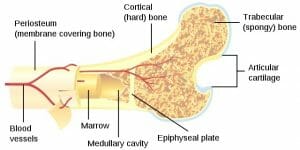Spongy bone and compact bone make up the long bones of the human skeleton. Long bones are longer than they are wide, like the tibia and the femur. In addition to long bones, the four other types of bones in the human skeleton are short bones (the tarsal bones of the wrists and feet), flat bones (skull, rib cage, sternum, scapula), sesamoid bones (knee cap) and irregular bones (vertebrae).
Spongy Bone
Spongy bone is also called cancellous or trabecular bone. It is found in the long bones and it is surrounded by compact bone. The term spongy comes from the fact that it is a highly vascularized and porous tissue. Trabeculae are spaces created in the tissue by thin areas of osteoblast cells. As a result, trabecular bone has about 10 times the surface area of compact bone. It also makes up about 20% of a human skeleton. Spongy bone is home to the bone marrow and hematopoietic stem cells that differentiate into red blood cells, white blood cells and platelets.
Compact Bone
Compact bone, also called cortical bone, surrounds spongy bone and makes up the other 80% of the bone in a human skeleton. It is smooth, hard and heavy compared to spongy bone and it is also white in appearance, in contrast to spongy bone which has a pink color. Compact bone is made up of units called lamellae which are sheets of collagen aligned in a parallel pattern that gives the bone strength. Blood vessels supply compact bone with oxygen and nutrients through structures called Haversian canals or osteons.

The image above shows the relationship between spongy bone and hard (compact) bone.
References
- Bone (n.d.). In Wikipedia. Retrieved September 27, 2017 from https://en.wikipedia.org/wiki/Bone
- Introduction to Bone. (n.d.). Retrieved September 27, 2017 from https://courses.lumenlearning.com/boundless-ap/chapter/introduction-to-bone/
Difference between Spongy Bone and Compact Bone
No comments:
Post a Comment